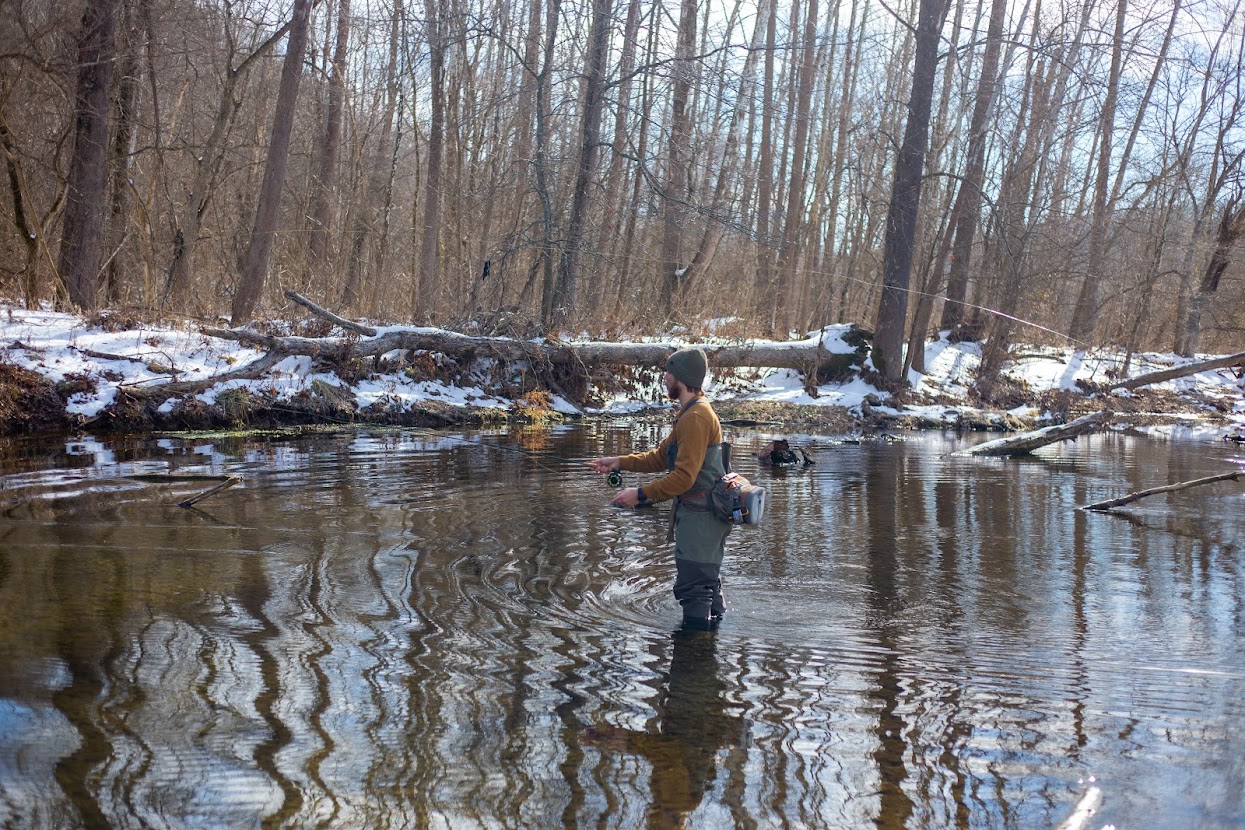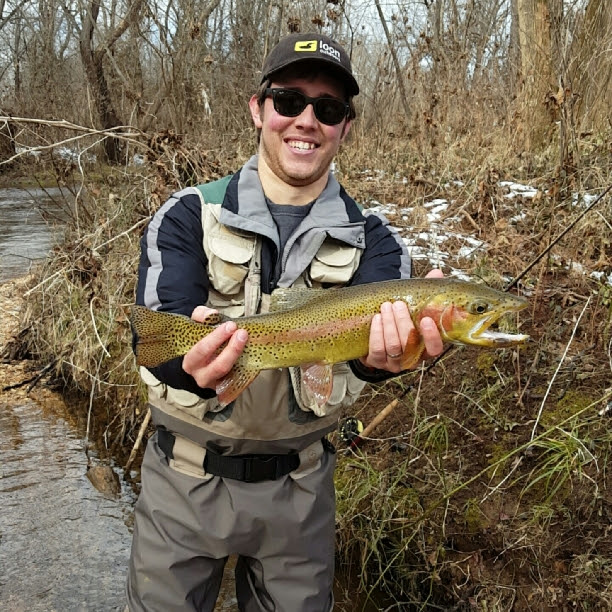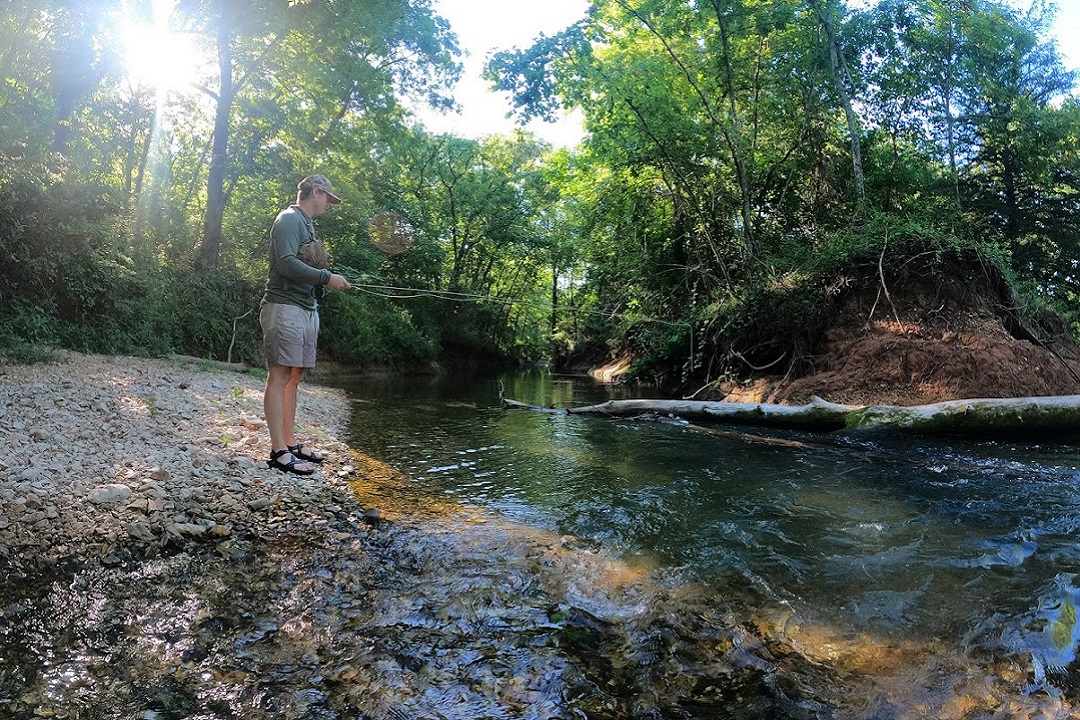I stared into the bubbling water, fly rod in hand. I watched the squirrels bound between the tall oaks. I listened to the rhythm of the water as it poured over the shallow rocks. I’ve been fly fishing since I was 12, but it always feels like the first time at Crane Creek.
The excitement built with every step and every fish that darted around in the water. I sat, drawing from my instincts, trying to decide what fly was going to produce fish for me. I saw the quick flash of a rainbow trout dashing for cover. I pulled out my fly line and prepared to cast, the whole time staring into the water, searching for the treasure held within.
It seems that each small town in southwest Missouri has its own legend. Reeds Spring has the Spanish Caves, where it’s rumored Spanish conquistadors left gold and gems in a cathedral room. Kirbyville has the Lost Treasure of Murder Rock, which tells of outlaw gang members burying their plunder in a cave near Branson. In fact, most of the legends about small towns in southwest Missouri are about treasure. Most of the tales are exactly that: Tales. Legends. Exaggerations built on minor historical events.
But there’s one tale that has its roots in Crane, Missouri, where evidence can be found if you know where to look. In Crane, there’s a treasure that people dedicate their lives to finding. If you frequent Crane Creek, you’ll have days where no matter what you do, you come back with nothing. Then there are days where everything fits together perfectly, and you find the treasure in abundance.
When you stop by Crane, the small town’s residents will light up if they get the chance to tell an outsider of their legend. They probably won’t tell you how to find it — folks around there tend to be secretive about that — but they’ll tell you how their creek came to be stocked with the last pure strain of McCloud rainbow trout.
Legend has it that, in the 1800s, a railcar was carrying a load of rainbow trout from the McCloud River in California to the east coast. The train broke down on the tracks that ran through Crane. Panicked, the railway workers knew they had to get the trout to colder water or they’d soon die. They decided to transport as many as possible to the creek to survive. At this point, the creek became home to a wild species of trout that has become lore among local anglers.
Now, some quick research will tell you that the Missouri Department of Conservation stocked this creek with the trout until the early 1920s. What’s astonishing is that these trout have survived here since that time. Most rainbow trout’s ideal water temperature is between 45 and 59 degrees Fahrenheit, but Crane Creek exceeds that during the hot Missouri summer. Despite the overwhelming odds against them, the McCloud rainbows have thrived in this small, too-warm creek.
– – –
The legend of the McClouds and the actual creek are about the only exciting things to come out of Crane, apart from the summer Broiler Festival, where you can enjoy local cooking and carnival rides that probably aren’t quite up to safety standards. You can drive through the town in a matter of minutes. There’s a town square, a park that surrounds the creek, baseball fields, and some houses. It’s about 30 minutes north, south, east, and west of nowhere.
The water is gin clear. Pin oak and silver maple trees hang over the water as if they’re trying to get a view at what lies beneath its surface. The creek, though small, acts as an artery to the woods and wildlife that call that section of the forest home. When you hike the trails to your destination, you’ll find deer, rabbits, and squirrels in abundance. It seems they, too, understand the magnificence that this water holds. There are moments where everything gives rise to bluff walls that line the water, which the trout use as a nice hiding spot to escape the heat or ambush their prey.
The water tells its own story. Most of the time the creek is so narrow you can almost lay your fly rod across it. There are also times where it grows to be over 20 feet wide, depending on the rain and water depth. The clear water turns to a beautiful, dark blue as the bed of the creek drops and opens into deep pools, the chests that hold the treasure that brought you there in the first place. These are the sights that make you forget you have a small human population near you. You could swear you’re the only person in the entire world. All that’s left is you, nature, and trout.
To pull a fish out of Crane Creek is no easy task. It’s said that if you can catch a McCloud rainbow, you’re a master of fly fishing. But if you catch a big McCloud rainbow, you’ve earned your Ph.D. The trout are smart, wily, and spook very easily. You make one step that’s too loud, or throw one bad cast, and you can say goodbye to your quarry as it flees for safety. At that point, you know it’s time to move on to the next hole. I’ve never seen a body of water humble so many anglers in my life.

Winter fishing in Crane Creek, Missouri.
Fly fishing is an art. It takes practice, it takes time, and it takes a lot of energy and observation. You have to see what the river is doing, what types of bugs are on the water, what type of bugs are in the water. You have to study everything about your surroundings, so that you can make sure your presentation of the fly upstream is perfect. The first thing I do at the river before I start to fish is flip over a few rocks. That’ll tell you what types of bugs are hatching beneath the surface and what type of fly to use.
I have a small group of friends that think the same way I do. Most of us have been good friends since high school, and fly fishing has been a key factor in keeping us in touch since we graduated. When we aren’t fishing, we’re talking about fishing. We tell stories and share all our secret spots with each other. These are the friends that first taught me about Crane Creek.
My first trip to Crane was all I needed to understand its appeal. It was a warm summer day, but that didn’t stop us, or the trout, from being active. When I set the hook on my first trout there, I had no idea what type of fight I was in for. My rod shook and bent, as if being tested to its limit. My first fish was only about nine inches long, which is average for that creek. When I pulled the trout from my net, I was awestruck by the deep green color on its back, white on the bottom, with a solid red and pink stripe running along the middle. It had circles, like little bands, running down the length of the pink stripe.
– – –
My friend, Zac, and I hopped into his early 2000s Silverado and left Springfield at 6 a.m. to get an early start. It was early February and it had just snowed the day before, a high of 33 degrees. We got to the water at 7 a.m., put on our waders, pieced together our fly rods, took a couple of swigs from the flask to stay warm, and then started trekking through the woods. We walked for about 20 minutes before we reached a spot in the creek we were happy with. We observed the bugs on the surface, flipped some rocks, and looked at the creek bed to see what the trout might be feeding on. Zac went with a smaller midge that represents a form of larva, and I went with a wooly bugger, which looks like a smaller baitfish or a leech. I figured food wouldn’t come as easily in the winter, so a big fish might jump at the opportunity for a high-protein meal.
The overhanging trees were coated with white, and there was a stillness in the air that only comes after a deep snow. You could see tracks where deer had moved through the night before. Zac drew my attention from the woods to show me a large trout that was cruising along the creek’s bed. He pulled line from his reel and made a cast at the passing fish. It went right past his midge without a second glance and continued upstream, out of view. We took turns spotting fish, letting the other make casts, and cursing at the trout that were too stubborn to even acknowledge our offering. We went the first half of our trip without a bite.
We hiked upstream, working our way back to Zac’s truck as we fished. We stopped to eat lunch, took a few more drinks of the whiskey, and then went back to the water to work our way farther downstream.
Usually at Crane you won’t see another person on the water, but we happened to run into someone packing up their gear for the day. Oddly enough, it was one of our friends that was coming back from the direction we were headed. He said he’d only caught three small fish. We were worried, but a few small fish were still better than none. We fished on.
Due to the snow and the runoff, the water was higher than normal. There were times where wading was difficult because of the deep holes and swift current. The fishing was tough, and we lost more flies in that short stretch than we had then entire day.
The woods opened to a bluff wall that lined the opposite side of the creek. Icicles clung desperately to the edge; the sun glistened through them. A sandbar created a peninsula with a run of water on the far side of the bar below the bluff, with another run right in front of us. The far side was deep enough that you couldn’t see anything except a deep, haunting blue. The sound of water running from the nearby hills bubbling into the creek was the only thing we heard. Zac drifted his midge through three times with no luck.
The run along the bluff was a textbook hole. There had to be a fish in there somewhere. I cast my line and let it drift absentmindedly while talking with Zac about what we should do with the rest of our day. As I looked back at the water, I noticed my fly line jump and then dive straight down. I set the hook.
My rod bent furiously as the trout peeled line away from my hands. I couldn’t see the fish. The drag on my reel was being tested to its limit, screaming furiously as the reel sang its fight song. I danced with the trout, careful to avoid breaking my light tippet. The trout came close enough to the water’s surface that we saw its massive sides flash a display of green and pink.
“Holy shit. That’s the biggest fish I’ve ever seen here,” Zac said, trying to keep his cool so I wouldn’t try to overdo it and lose the fish.

The author with a trophy Crane Creek trout.
Zac would be my “net man,” the one to actually capture the fish I was fighting. The only problem was we didn’t have a net with us. He was going to have to grab this strong, elusive fish with his hands without letting it get off the hook.
The fish made a few strong runs. I chased after it in the creek so it wouldn’t get too far away and tangle itself on a downed tree or free itself somehow. I pulled it to the surface, only for it to bolt away. After five minutes of this fish running me back and forth along the bluff, I got him to a point where Zac could grab him. The exhausted fish let itself get dragged right toward Zac.
The trout caught a second wind once it saw Zac. It streaked back to life and swam right through his legs, causing my fly line to get tangled up on his waders. Zac was too deep into the creek to move very gracefully.
“Zac, get out of the way of that fish!” He maneuvered around the fly line, navigating the rocky creek bed. Luckily, he was able to free the line from his legs without causing any problems.
After a few additional minutes of fighting the behemoth, I was able to get him to shore. As soon as I saw Zac had a firm hold, I threw my rod down in excitement and screamed. My hands trembled as I went to grab the fish from Zac. The hook fell out of the fish’s mouth as soon as I touched it. I sat and stared at the fish in disbelief.
“Dude, you better get him back in the water. You’ve had him out for a while now,” Zac said as he put his hand on my shoulder, bringing me back to reality.
The 22-inch trout dwarfed the biggest fish I’d seen out of the creek, which was 18 inches. Due to the natural spawning season, the colors on the trout were deeper than usual. The pink stripe along its side was almost red. His jaw was bent up and scarred on the bottom from fighting with other fish, claiming his territory for the spawn. I was in awe.
After a few pictures, I released the trout, watched him swim lazily back to the depths, and disappear. Many people have fished Crane Creek their entire lives looking for a treasure like that without finding it. I sat on the bank, thinking about that fish. Other towns may have their legends, but I held proof of Crane Creek’s in my hands, and I let it go.
Author: Casey Callison is a contributor to Terrain Magazine.


I use 2 own property that crane creek runs thru I have caught some over 10 lbs
That is a great article! On so many levels.
[…] Park Info: https://mdc.mo.gov/fishing/species/trout/trout-parksCrane Creek Essay: https://terrain-mag.com/crane-creek-fly-fishing/American Fly Fishing Mag: https://americanflyfishing.com/ALT Fly Fishing […]